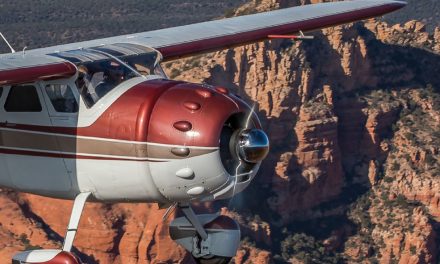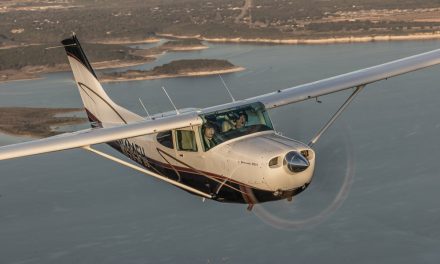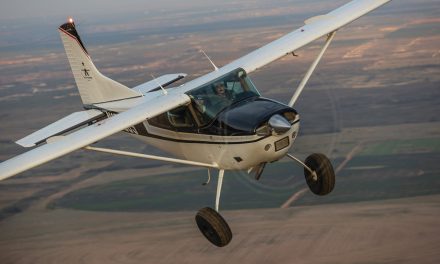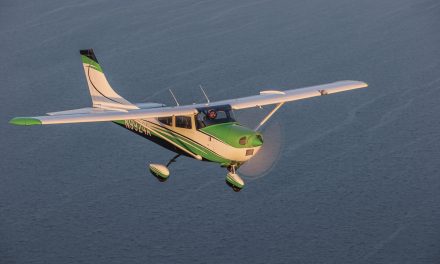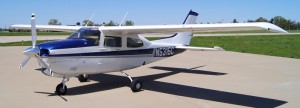 Cessna’s top-of-the-line high wing cruiser, now out of production since 1986, still merits a second look.
Cessna’s top-of-the-line high wing cruiser, now out of production since 1986, still merits a second look.
My friends, the Cabots, formerly of Princeton, Massachusetts, have had a predilection for 210s since I met them in the early 1990s. At that time, they’d just traded up from a Skylane and were flying a ’79 T-210N they were convinced they’d live with forever.
It didn’t turn out that way. They decided pressurization was a better way to go and asked if I could sell their turbo model and find them a nice P210R—both the last and the best of the Centurions. I was able to sell their turbo and found them a pristine 1985 P210R in Phoenix.
They jetted out from Massachusetts the following day, bought the airplane on the spot and have lived happily ever after. Today, they’re retired in Mexico, and they fly back and forth to Texas, Arizona and California on a regular basis.
Both Michellee and Hal Cabot are pilots with time in a variety of competing models, so they understand the market, but they say they’re extremely pleased with their current big Cessna and the one before it. If they decide to sell now, it will be to get out of aviation altogether.
As mentioned above, the Cabots are dedicated Cessna fans. Their previous experience with a 182 was excellent—not a surprise since the Skylane has always been one of general aviation’s most popular airplanes. The lure of extra hp, better speed and climb, plus the benefits of a big cabin and extra payload seduced them into buying a retractable.
A 210 was an obvious next choice. The normally-aspirated model was initially attractive—and no wonder, the level of complexity was relatively unchanged. Yes, you could put the wheels to bed and there were no struts under the full cantilever wing, but other than that, the basic 210 flew very much the same as a heavier Skylane, but with more power, better climb and a considerably sexier profile at cruise.
Back in 1960, the first 210s began life with four seats, struts and 260 hp, but the latter only lasted until 1964 when Cessna upped power to 285 and increased seating capacity to six. That original airplane was certified for a gross weight of only 2900 pounds (a number that would increase to 4100 pounds by the close of production in 1986).
The full cantilever, laminar flow wing came along in 1967, and power was bumped up again in 1970 to 300 hp. The first turbocharged version was introduced in 1966, and there were scores of other, minor changes made throughout the ’70s.
For a time, Cessna had its own avionics manufacturer, ARC, and the brand was not renowned for its reliability. As a result, many buyers purchased King radios and Cessna eventually responded by refusing to offer any competing avionics for a time. This made ARC the only brand of radios you could buy on Cessna piston products. One unexpected result was that literally hundreds of new Cessnas were delivered totally naked of any avionics at all. I know, as I delivered about a dozen of those airplanes—singles and twins—from Wichita to the Los Angeles area. It felt strange to fly a 340 or 414 one thousand miles west with a panel bare of everything except basic flight instruments. The dealer would have a radio shop install King radios in California.
The most popular of the Centurions was probably the turbo model. Since the Cabots now do much of their flying in the Mountain West, a blower out front seemed a good idea. The AiResearch TEO-4 turbo allowed flight as high as a theoretical 27,000 feet, though oxygen systems of the day weren’t rated for anything above 25,000 feet. Even so, the T210 was a great high flyer, capable of topping everything but the most aggressive of thunderstorms.
Cessna’s project engineer on the P-210 program, Phillip Hedrick, had his work cut out for him in attempting to sandwich a larger capacity turbo under the bonnet of the 210. The bigger turbo was needed to provide enough bleed air to pump up the cabin while not restricting the airplane’s climb or cruise performance. To help seal the cabin, the pilot’s door was fitted with multiple, heavy duty pins and the windows were rounded and reduced in size. Cessna fitted an airtight bulkhead behind the rear seats.
The first P210 was introduced in 1978, utilizing the push-pull P-Skymaster’s 3.35 psi pressurization system. The finished P210N was about 180 pounds heavier than the T210N, one of the inevitable costs of pressurization.
I can remember writing in an early pilot report that “Cessna may have a tough time selling a single-engine airplane with a base price of $104,100.” Wrong! They sold a bunch of them. Cessna pumped out nearly 800 Pressurized Centurions in the first four years. (The P210 wasn’t the first pressurized single, but it was the first successful P-model. Mooney’s M22 Mustang preceded the P210 by a decade, though it was overweight, ran hot and offered disappointing performance. Mooney shelved the Mustang after only three years of production.)
Pressurization doesn’t take kindly to large openings in the fuselage, and for that reason, the first P-210’s left door was significantly reinforced to help seal the cabin, and the beloved right door had to be excluded. To satisfy the FAA’s requirement for two exits on any six-place airplane, Cessna mounted a half-door emergency exit that folded up against the bottom of the wing. (Interestingly, rather than mount a second door on the P-Skymaster, Cessna chose to limit the airplane to five seats.)
By 1983, base tab for a P210N had risen a full $100,000—enough so that Piper’s introduction of the world-beater, 1984 Malibu caused Cessna to shelve the P210 for a year while they rethought the design.
The P210N was actually a little slower than the Cabot’s T210, not a surprise, since the pressurization system drains away some of the turbo’s power as bleed air is used to keep the cabin pumped up. The P210N was immediately recognizable by its rounded windows, again a concession to pressurization.
The final version of the P210, the R model, was introduced in 1985. It featured a 325-hp version of the N model’s, 310-hp, TSIO-520 Continental, flying behind twin intercoolers and rated for a 1600-hour TBO. The horizontal stabilizer offered a wider elevator to lend more pitch response to what had been a ponderous regime, and the wing sported three feet more span to improve climb. Cessna’s specs suggest the R model ascended at 1150 fpm—200 fpm better than the N Centurions.
Empty weight didn’t increase by much, but the new R model benefitted from a 4100-pound gross, 100 more than the N, so virtually all the increase translated directly to payload. The new airplane had a service ceiling of 25,000 feet. Since pressurization remained at 3.35 psi, pilots and crew would have needed supplemental oxygen, as the cabin would have been above 12,500 feet. Many 210 lovers regard the P210R as the best of the type.
The Cabots seem to agree. “The P210R suits us well,” says Michelee. “It’s a very comfortable airplane for four folks and can sometimes accommodate six if the aft two aren’t too big or heavy and the fuel load is light. Getting into the rear seats can require the agility of a gymnast, so that area is usually reserved for extra baggage. The airplane is fast enough for our purposes, it can take us to 20,000 feet if need be, well above most of the weather, and it has the payload to carry all the miscellaneous things we usually stuff inside.”
Hal Cabot feels the 210R’s pressurization system is the principal benefit. “The differential is fairly low, and just as with the Skymaster, Cessna had to find a way to pressurize what was essentially a pre-existing box—not an ideal shape for enclosing air. Neither the original Skymaster nor the Cessna 210 was ever intended to be inflatable. Pressurization was added later, and for that reason, the basic fuselage shape remains more rectangular than round. Accordingly, the P210’s system wasn’t nearly as stout as the Mirage’s 5.5 psi.
“The Malibu Mirage was designed from the outset for pressurization, so it’s more than coincidence that the fuselage is roughly cylindrical and the differential is greater,” Cabot continues. “When everything is working correctly on our P210R, we see a cabin altitude of between 10,000 and 11,000 at 20,000 feet, but in fact, we rarely fly that high. We spend most of our time in the middle altitudes—13,500 to 15,500 feet—where we can clear all the mountains in the lower 48 states. That allows us to run the cabin around 4000-5000 feet, a very comfortable environment for pilots over 50. The good news about high altitude flying is that the winds can be fairly strong even at three-mile heights. That can be a big help if you’re flying in the proper direction.”
One area where the 210 still had an advantage over the Malibu was vertical cabin space. Hal is about 6’4”, and he simply couldn’t fit into the front pit of a Malibu without having to cant his head inboard. “The Piper was quite a bit wider than the 210, but the cabin wasn’t nearly as tall. That decided us in favor of the P210R.”
The Cabots report typical cruise speeds of 170 to 180 knots at middle altitudes, burning 20-21 gph. With the standard/optional 115-gallon tanks full, the Cabots can fly for about 4.5 hours plus reserve—enough for cross country trips of 800 nm.
Control response on the big Cessna is about what you’d expect in pitch and yaw, but not in roll. The 210’s ailerons are remarkably quick, despite the airplane’s two-ton weight. A combination of large control surfaces and high aerodynamic loads make for an unusually fast ability to maneuver.
When it’s time to return to Earth, the P210R is, after all, a big-wing Cessna, and that means those huge flaps are available to give the airplane near-Skylane short field performance. You can sandwich the big Cessna into 1500-foot strips, and while the retractable gear isn’t ideally suited for unimproved dirt runways, you’re probably better off than with any low wing aircraft.
When Cessna elected not to return the 210 to production in 1996 after the ten-year hiatus, the primary reason was that the airplane was highly labor intensive to build, and it would have been too expensive to produce. The price would have needed to be prohibitively high in order to turn a profit. Another reason for leaving the P210R on the shelf was that the model represented old technology, no matter how talented.
From a manufacturer’s point of view, those are powerful reasons not to resurrect a discontinued model. Yet, the 210 generically, and the P210R specifically, will always have a certain appeal to pilots who appreciate the type’s rock-solid stability in cross country mode.
Specifications & Performance
Cessna P210R Pressurized Centurion
All specs and performance numbers are drawn from official sources, often the aircraft flight manual or the manufacturer’s web site. Other common sources of information include Jane’s All-The-World’s Aircraft and Penton’s Aircraft Bluebook Price Digest.
Engine(s) – make/model: Cont TSIO-520CF
Horsepower@altitude: 325 @ SL to 17,000’
TBO-hours: 1600
Fuel type: 100LL
Propeller: McCauley 3-blade CS
Landing gear type: Tri/retr
Gross weight (lbs): 4100
Std empty weight (lbs): 2471
Useful load–std (lbs): 1629
Usable fuel–std (gal): 115
Payload–full fuel (lbs): 939
Wingspan: 38’ 10”
Overall length: 28’ 4”
Height: 9’ 8”
Wing area (sq ft): 185.5
Wing loading (lbs/sq ft: 22.1
Power loading (lbs/hp): 12.6
Wheel size: 6.00 x 6
Seating capacity: 6
Cabin doors: 1 1/2
Cabin width (in): 44
Performance
Cruise speed (kts–75%): 190
Fuel burn (gph-75%): 20/21 (est.)
Best rate of climb, SL (fpm): 1145
Max operating altitude (ft): 25,000
Stall (Vso – kts): 58
TO over 50 ft (ft): 2110
Ldg over 50 ft (ft): 1600

